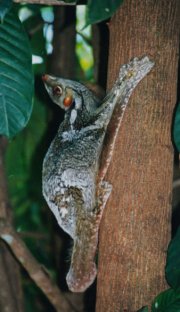 Despite its name, the Malayan flying lemur (Cynocephalus variegatus) cannot actually fly, and is not related to the lemurs of Madagascar. Instead it is a glider, which uses its gliding membrane (patagium) to glide between trees. The patagium is as large as possible, stretching from its shoulder blade to their fore-paws, from their fore-paws to their to their toes and from their toes to their tail.
Despite its name, the Malayan flying lemur (Cynocephalus variegatus) cannot actually fly, and is not related to the lemurs of Madagascar. Instead it is a glider, which uses its gliding membrane (patagium) to glide between trees. The patagium is as large as possible, stretching from its shoulder blade to their fore-paws, from their fore-paws to their to their toes and from their toes to their tail. Malayan flying lemurs live in Thailand, Malaysia, Singapore and Indonesia. They are resting during the day, but active at night and their diet consists of young leaves, shoots, fruit and flowers. The loss of rain forest to the timber industry and agriculture results in loss of habitat for the Malayan flying lemurs. People hunt them for their fur and meat.
Interesting fact Flying lemurs are also known as 'Colugos' or 'Cobegos', which leads to less confusion since they cannot fly and are not directly related to the lemurs in Madagascar.
Picture of the Malayan Flying Lemur: original by Nina Holopainen, licensed under Creative Commons Attribution 2.5
The Malayan flying lemur is listed as Least Concern (LR/lc), lowest risk. Does not qualify for a more at risk category. Widespread and abundant taxa are included in this category, on the IUCN Red List of Threatened Species
Namings for the Malayan flying lemur
A Malayan flying lemur group is called a 'troop'.
Custom Search